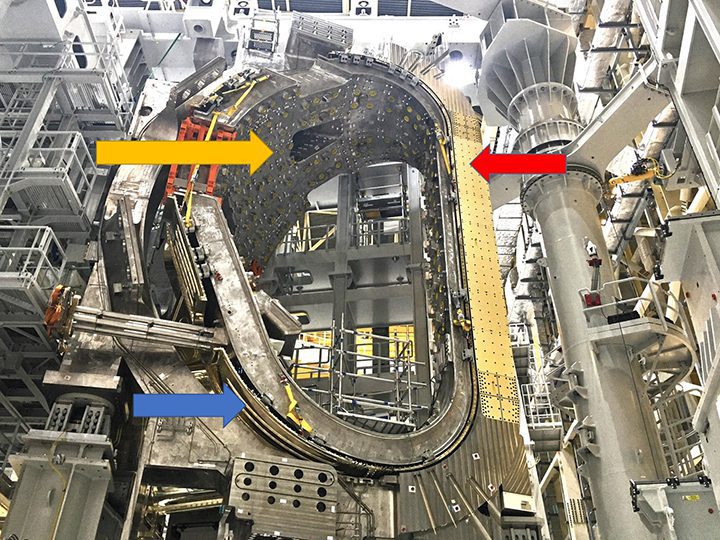
Fusion occurs when two atoms slam together to form a heavier atom, such as when two hydrogen atoms fuse to form one helium atom. A tremendous amount of energy is released in the process.
This is the same process that powers the sun. In the sun’s core, where temperatures reach 15,000,000C, hydrogen atoms are in a constant state of agitation. As they collide at very high speeds, the natural electrostatic repulsion that exists between the positive charges of their nuclei is overcome and the atoms fuse. Without fusion, there would be no life on Earth.
Significant research has been done to better understand the fusion process since the concept was first theorized in the 1920s. Scientists have answered most of the key physics questions behind fusion. Today, in southern France, 35 nations are collaborating to build the world’s largest tokamak—a magnetic fusion device designed to prove the feasibility of fusion as a large-scale and carbon-free source of energy.
The ITER project (Figure 1), as it is known, is expected to be the first fusion device to produce “net energy,” which is the term used when the total power produced during a fusion plasma pulse surpasses the thermal power injected to heat the plasma. ITER could be the first fusion device to maintain fusion for long periods of time, and it is expected to be the first fusion device to test the integrated technologies, materials, and physics regimes necessary for the commercial production of fusion-based electricity.

“I’m optimistic. I think in 10 to 15 years, we could have a commercial fusion energy plant producing electricity on the grid,” Chuck Goodnight, lead partner in the U.S. on U.S. Nuclear Energy as part of Arthur D. Little’s Global Energy & Utilities practice, said as a guest on The POWER Podcast. If Goodnight’s prediction is correct, the entire landscape of power generation could be transformed not only in the U.S., but also around the world.
“In the 1950s, we had very few nuclear power plants, and then in the U.S. within 35 years or so we had 100,” Goodnight said. “I can envision that same future for small modular reactors and fusion—and that could be global in my vision. And at that point, hopefully, there’s renewables, there’s fission, there’s fusion, and there ultimately would be no carbon-based fuel systems running. And people could look around the planet and look back with gratitude to the people of today that have spent time and money and energy and sweat to make these technologies viable and to get them to market and to get them into a grid that is sustainable,” he said.
“So, I’m optimistic because we’ve got a lot of smart people and quite a bit of funding now behind these ideas to get these things going, and the government’s behind them and the private equity behind them and private funding and innovative people that are clearly a big part of this. I think there’s a lot of reasons to be optimistic about our future,” said Goodnight.
In the meantime, Goodnight expects natural gas-fired power plants to fill an important role in bridging the U.S. power system to a future filled with fusion energy. He acknowledged that renewable resources would be part of the power mix, but he said, “Ultimately, renewables can’t be 100% of the solution.” Goodnight suggested that because wind and solar power are intermittent, they can’t by themselves provide reliable baseload power, which is why he feels gas is so important in the near term. “You need to have the flexibility of having the 24/7 baseload amount, followed by a variable amount that will vary depending on, primarily, the weather,” he said.
“That will eventually get us to—hopefully, in maybe 15 or 20 years—to a state where the fusion technology is actually transitioned from technology to power plants. And then from there, we’ll start really building fusion plants that solve a lot of these issues, because they’ll both be small enough to be local, as well as load following to be able to work with the new mix, which will be, I think, primarily renewables, and then residual fission and new fusion.”
To hear the full interview, which includes more about small modular reactors and Goodnight’s expectations for that technology, listen to The POWER Podcast. Click on the SoundCloud player below to listen in your browser now or use the following links to reach the show page on your favorite podcast platform:
For more power podcasts, visit The POWER Podcast archives.
—Aaron Larson is POWER’s executive editor (@AaronL_Power, @POWERmagazine).
The post Could Fusion Energy Transform the Power Industry By 2035? appeared first on POWER Magazine.